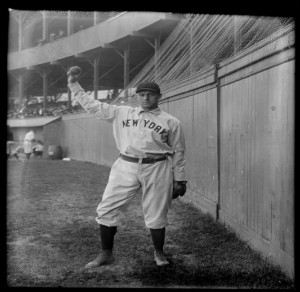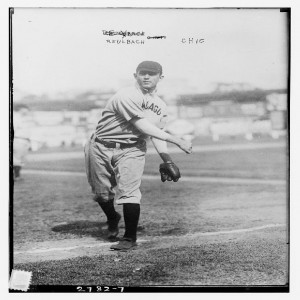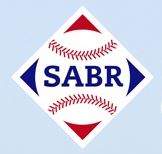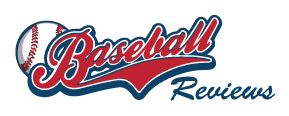On this date (September 26) in 1908, Chicago Cubs’ right-handed hurler Ed Reulbach did something that is (and, undoubtedly will remain) unique in MLB history. On that date, Reulbach (known for his high-kicking delivery and sharp-breaking curveball) started both games of a double header (versus Brooklyn) for the Cubs. And, starting both games of a double header is not what’s unique – it’s been done more often than you’d think and as recently as 1973. There’s also been an instance of both teams starting the same pitcher in both games of a double bill and a major league hurler who started both ends of a double header three times in one month. More on all of that later, let’s get back to Ed Reulbach. It is, after all, his day.
Reulbach won both games of that September 26, 1908 doubleheader and – as was expected at the time – went the distance in both contests. But that still is not what makes Reulbach’s afternoon of work unique. In MLB history, 42 different pitchers have accounted for two complete game victories in one day a total of 52 times (The requirements being that the pitcher start and finish the contest regardless of innings.) Note: 26 NL pitchers/35 times; nine AL pitchers/nine times; four American Association pitchers/five times; three Players League pitchers/three times.)
What makes Reulbach’s accomplishment unique is that he is the only MLB pitcher to throw two complete game SHUTOUTS on the same day. The Cubs were involved in a heated pennant race and the pitching staff was reportedly growing arm weary. So, Cubs’ player-manager Frank Chance called on Reulbach to toe the rubber in both ends of a double header against the Brooklyn Superbas (Dodgers). Reulbach responded by shutting down the Brooklyn squad 5-0 in game one and 3-0 in game two – giving up just eight hits in 18 innings on the day. The extra work didn’t seem to bother the right-hander, as he came back after four days rest to shut out the Reds in his next start. Just how critical were Reulbach’s two September 26 wins? The Cubs won the 1908 pennant with a 99-55 record – one game ahead of both the Pirates and the Giants.
Reulbach’s accomplishment should not have been a surprise. “Big Ed” was on the way to a 24-7, 2.03 season in which he would lead the NL in winning percentage for the third consecutive year. Reulbach’s final major league tally, over 13 seasons, was 182 wins, 106 losses and a 2.28 ERA. His MLB accomplishments also include a 17-game winning streak, a 44-inning scoreless streak and a World Series one-hitter (1906).
Now, a few other facts about pitchers who started both ends of a double bill.
Knuckleballer Wilbur Wood was the last pitcher to start both ends of a twin bill – although (unlike with Reulbach) that was not the original plan. On July 20, 1973, Wood started the first game of a double header for the White Sox (against the Yankees). He got off to a good start, whiffing Yankee lead-off hitter 2B Horace Clarke on a wicked knuckler. Unfortunately, the pitch also fooled catcher Ed Hermann and Clarke reached first on a passed ball – which proved the highlight of Wood’s game. In order, he followed up with: a walk to RF Matty Alou; a two-run double to LF Ron White; a run-scoring single to CF Bobby Murcer; an RBI single to catcher Thurmon Munson; a run-scoring single to 3B Graig Nettles; and an early exit in an eventual 12-2 loss. Given Wood’s short stint on the mound (reported at less than 30 pitches) and the lack of stress placed on a knuckleballer’s arm, Sox manager Chuck Tanner sent Wood back to the mound to start game two. The results were marginally better. Wood lasted 4 1/3 innings, giving up seven hits and five runs, earning his second loss of the day as the Yankees triumphed 7-0. Workhorse Wood, by the way, ended the 1973 season with 24 wins and 20 losses, the last American Leaguer to win and lose 20 games in the same season (Phil Niekro did it in the NL in 1979).

Joe McGinnity started, and completed, both end of a double header three times in a single month- and won all six games.
Then there is Joe McGinnity, who started both ends of a double header a record five times in his career, and three times in a single month. Notably, in August 1903, McGinnity not only started both ends of a double header three times, he also won all six games and completed all six.
Pitching for the New York Giants, on August 1, 1903, McGinnity won the first game of a double header against the Braves 4-1 and came back to win the second game 5-2. Just a week later (August 8), he repeated the feat, beating Brooklyn by scores of 6-1 and 4-3. Then on August 31, he topped the Phillies 4-1 and 9-2. McGinnity finished the season 31-20, 2.43 and recorded 246 wins, 142 losses and a 2.66 ERA in ten MLB seasons, during which he led the NL in wins five times.
Then there is Bob Newsom, who started both ends of a double header four times (1934, 1937, 1938, 1945) for three different teams (Browns, Red Sox, Athletics) in his 20-year MLB career. (Newsom went 211-222, 3.98 for nine teams from 1929-53. He was a four-time All Star and a three-time 20-game winner, as well as a three-time twenty-game loser.)
The Newsom double-header/double-start that attracted my attention came on September 14, 1934 – mostly for the total between-game turnaround by Newsom. Pitching for the St. Louis Browns, Newsom started the first game of a double header against the Athletics – and walked the first four hitters before being pulled. Brooklyn Manager Rogers Hornsby (for some reason) sent Newsom back out to start game two. This time, he totally reversed his fortunes, striking out the first four hitters and picking up a complete game 5-2 win. Newsom’s other instances of starting both ends of a double header were more traditional – and resulted in two wins and three losses.
When the Braves and Phillies faced off in a double header on August 12, 1921, they collaborated to make MLB history – with both teams sending the same starting pitcher to the mound in both games for the only time ever. George Smith was the Phillies’ double-starter, while Jack Scott did the same for the Braves. Scott was the losing hurler in both games, while Smith tossed a 12-hit shutout to win game two. (Both pitchers were knocked out of game one by the third inning, Scott taking the loss, Smith getting a no-decision.) Smith, by the way, was on course for a 4-20, 4.76 season, while Scott would finish the year 15-13, 3.70. Both hurlers had career records under .500.
To end, here are a few other hurlers who started both ends of a doubleheader: Cy Young, Old Hoss Radbourn, Grover Alexander, Babe Ruth, Don Newcombe, and Rube Waddell – as well as Hippo Vaughn, Mule Watson and Happy Finneran.
With that, let me just say – Happy Ed Reulbach Day.






